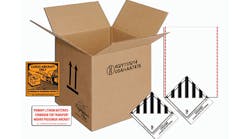It's not your imagination. Returns are increasing—especially in e-commerce. While everyone thinks of returns after Black Friday and throughout the holidays, they're really a topic that affects retailers and manufacturers all year long.
Certain commodities in the e-commerce space see returns as high as 30%. For some perspective, traditional retailer returns tend to be around 10%. This increase on returns means many organizations are now turning their attention to creating effective return programs. This has coincided with real innovations being developed for handling unwanted items.
Who Handles Returns?
Many manufacturers and retailers run their own returns processing operations, while others utilize a third-party provider. Return disposition operations can be both labor- and cost-intensive. This is where third-party providers can help. When it comes to reverse logistics strategies, third-party providers bring three types of advantages to the table:
Location. Many third-party returns processing companies have regionalized facilities to reduce transportation expenses.
Software. Some third-party providers utilize proprietary software that allows them to quickly disposition returns and pass those returns on to the proper destination. The software also helps users maintain better visibility to the overall process.
Scale. Since third parties are able to distribute the cost of the returns facilities and software across many customers, the marginal cost of adding customers can be much smaller than when an organization wants to start from scratch.
Additionally, some third-party providers specialize in returns handling. This allows them to evolve and learn from one customer to the next.
Where Returns Actually End Up
To truly understand the changes happening in the returns sector, we need to discuss what happens with returns. Typically after an item is returned—whether in store or shipped back to a distribution center (DC) from an online order—one of four things can happen: return to stock, return to vendor, liquidate, or discard. Each return is given a disposition by the returns processing facility.
Wrong Color, Wrong Size, Just Wrong
By far, the most common reason for returns—especially in the e-commerce space—is that the customer simply changed his or her mind. Because there's nothing wrong with the item, this type of return is one of the simplest to handle.
These returns typically end up right back on the shelf. Traditional retail stores can do this very quickly as the buyer has to physically return the item to their store. E-commerce organizations often have longer restocking cycles as items cannot be returned to inventory until the buyer ships the item back to the warehouse—a process that can take days or even longer.
To help counteract these cycle times, some third-party facilities offer fulfillment operations. This allows the customer to have their returns shipped to the returns processing provider, have the product dispositioned, and then have it fulfilled directly from the returns processing provider. This also saves on the line haul costs generally incurred between the returns processor and fulfillment provider.
Fix It if It's Broken
Damaged items certainly account for another large chunk of returns. Some—although certainly not all—vendors require retailers to ship broken products back to them. Once returned to a manufacturing facility, vendors inspect these items, refurbish them, or use them for parts as appropriate. This is especially common for more complex items like appliances, mobile technology and computer equipment.
Making repairs to these types of items allows companies to recover a significant portion of their original price—even to the point of still making a profit. Some companies utilize their own manufacturing facilities and labor to perform repairs while others work with external remanufacturing centers. These dedicated third-party facilities are generally pre-stocked with parts to repair and trained with people knowledgeable in the remanufacturing process of the returned goods.
The key to remanufacturing is that it's more expensive than typical returns processing. Therefore, the commodity being returned needs to have enough value to justify the additional work.
Gone Are the Days of Waiting to Liquidate
There are many reasons why items are liquidated. It could be that the item is damaged but still usable (e.g., a dented toaster), or that the items are out-of-date (e.g., cellphone cases for an older model phone). Liquidation used to be a final effort to recover any money on returned items. With the number of returns climbing, liquidation strategies are quickly changing.
Recovering as much as possible from returns—especially when numbers are high—is more important than ever. Companies can no longer afford to allow liquidated items to pile up in a warehouse to be dealt with later. Prompt action and a little help from technology yields the best opportunities to resell for the highest recovery value.
Similar to their popularity with consumers, online marketplace platforms are becoming the go-to process for liquidated items. The process for taking pictures, creating a manifest, working with an online marketplace, and even shipping directly to the highest bidder from the warehouse can be handled either internally or by a third-party provider based on the needs of the organization.
The key to effectively running the operations for a liquidation auction marketplace is velocity. Goods need to move in and out of the facility as quickly as possible to maximize returns and reduce expenses.
When shipping to the buyer of liquidated goods, it is important to consider whether or not you want to relinquish control of the shipping to the buyer. When buyers handle transportation, the subsequent inconsistent transportation flows can slow down the entire facility.
Things that No One Will Buy
No one likes waste, and there's surprisingly less than you'd think in the returns space. Thanks to the primarily immediate nature of e-commerce returns, most organizations can resell items rather than discard them entirely. Recycling is always an option for items being disposed of, and for some commodities—especially tech products—recycling is a requirement.
Keeping items out of landfills isn't always an option, but all properly managed returns programs use it as a last resort. After all, it doesn't yield the company anything other than a complete loss.
A Well-Thought-Out Reverse Logistics Strategy
More returns means an effective returns program is not just a perk or a mere selling tool anymore. It's become a minimum barrier to entry for e-commerce companies and is slowly becoming the same for traditional retailers as well. But beyond recouping potential losses from returns, what is required for a returns program to be successful?
First and foremost, it's the customer experience. Customers want easy returns and fast refunds. While their expectation of these things is still being formed, free returns and rapid refunds are quickly becoming the norm rather than the exception.
The part that many organizations forget about when creating their returns program is how to avoid returns in the first place. As mentioned earlier, the majority of returns are simply because it was the wrong item, not that it was a damaged item. In the world of e-commerce, where consumers can't try on clothing or see the actual color in person, it's important to provide comprehensive descriptions and details about the products up front. The details will obviously vary by commodity but basic measurements and other customer reviews can help paint a clear picture for online shoppers even before they buy.
Reverse logistics is all about maximizing the value of products. For returns, that means gaining value for items after they've been in consumers' hands. But what about the process for overages, shortages and damages—items that don't even make it to the shelf? Or items that must be pulled from the shelves for safety recalls? These and other areas all play a part in maximizing value of all products.
Bryan Freeland is business development manager, emerging services at C.H. Robinson, a supply chain management and third-party logistics provider.




